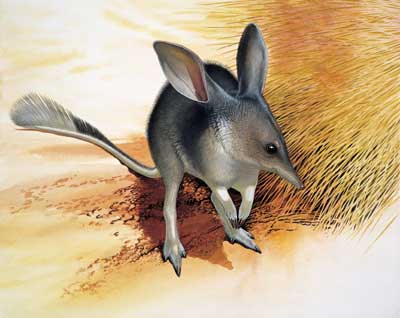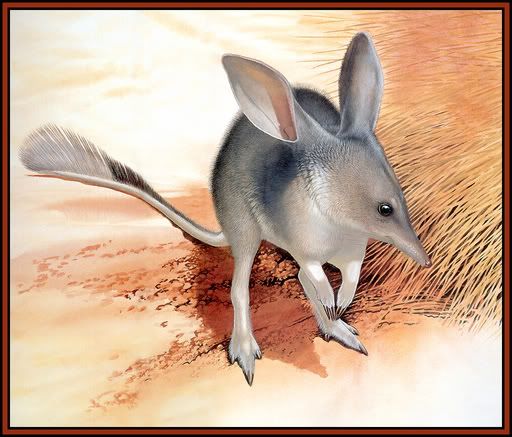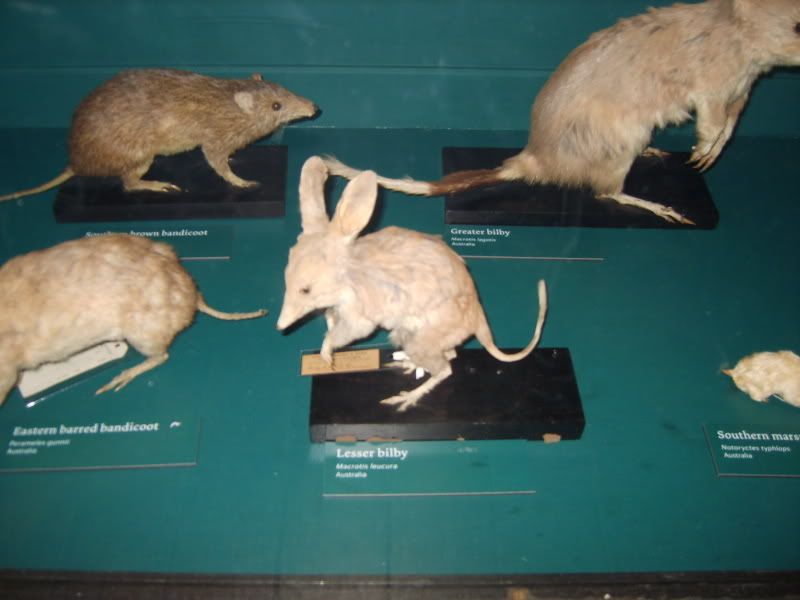|
|
Post by Melanie on May 21, 2005 20:50:53 GMT
Macrotis leucura was endemic to Australia. The last confirmed collection of a specimen was in 1931.
The species was associated with soils suitable for burrowing in areas such as savannah, sparsely vegetated deserts and xeric shrublands.
The population was drastically reduced throughout the early twentieth century as a result of the animal being trapped for its pelt. This along with predation from introduced species such as foxes and competition with rabbits for burrows is thought resulted in the extinction of this species.
|
|
|
|
Post by another specialist on May 21, 2005 21:13:06 GMT
|
|
|
|
Post by another specialist on May 21, 2005 21:17:15 GMT
The lesser bilby was an inhabitant of Australia’s driest deserts, and recorded as a living animal on just a handful occasions between its discovery in 1887 and its extinction in the 1950s. It seems to have been moderately abundant on Cooncherie Station in the summer of 1932, where Hedley Herbert Finlayson collected a dozen specimens. These were all caught by an Aboriginal helper who ‘seldom returned without 2 or 3 after a morning’s work and I suspect many found their way to the cooking fires as well’. These were, however, the last to be collected alive. Unlike most members of the bandicoot group to which it belongs, the lesser bilby was a carnivore, and native rodents were recorded among its prey. And unlike the gentle and still surviving common bilby, it had a nasty temperament. Finlayson noted it was ‘fierce and intractable, and repulsed the most tactful attempts to handle them by repeated savage snapping bites and harsh hissing sounds’. It burrowed only in sand dunes, constructing burrows two or three metres deep, closing the entrance with loose sand by day. It was strictly nocturnal, twins were standard, and reproduction may have been non-seasonal. The last recorded specimen consists of a skull picked up below a wedgetailed eagle’s nest by P. Hanisch at Steele Gap in the Simpson Desert, Northern Territory, in 1967. The bone was still relatively fresh, and was estimated to be less than fifteen years old. rainforestinfo.org.au/spp/Schouten/lesser_bilby.htm |
|
|
|
Post by another specialist on Jul 31, 2005 7:19:37 GMT
|
|
|
|
Post by another specialist on Jul 31, 2005 7:21:28 GMT
Lesser Rabbit-bandicoot or Bilby also known as Yallara
|
|
|
|
Post by another specialist on Jul 31, 2005 7:24:00 GMT
The Lesser Rabbit-bandicoot Bilby also known as Urpila (Macrotis leucura minor) from Central Australia extinct 1900 so two races at least are known the nominate Macrotis leucura leucura and Macrotis leucura minor. planet-mammiferes.org |
|
|
|
Post by another specialist on Oct 20, 2005 13:45:52 GMT
The Lesser Bilby was originally described by Oldfield Thomas as Peregale leucura from a single specimen among a collection of mammals forwarded to the British Museum by J. Beazley of Adelaide (Thomas 1887a). At the time, Beazley was taxidermist in the South Australian Museum (Jones 1923). The exact locality was not recorded by Beazley, but Thomas (1887a) noted that other specimens in the collection were either ‘...North Australian species...’ or had been ‘...obtained in the neighbourhood of Adelaide itself’. Jones (1923) considered that it came from northern South Australia. The specimen was a young male still with its ‘...milk premolar’ and well preserved in spirit (Thomas 1887a). A further five specimens collected ‘about forty miles to the north-east of Charlotte Waters’ were sent by the then telegraph operator P. Byrne to Baldwin Spencer who described them as Peregale minor (Spencer, 1896)c on the basis of skull measurements and length of the molars. Forty miles north-east of Charlotte Waters places the collection locality at approximately 20°40'S; 135°12'E in sand dune country of the Simpson Desert in the Northern Territory. A further three specimens labelled ‘Barrow Creek, 1901’ are in the Museum of Victoria. Parker (1973) questioned the validity of the locality on the basis of the absence of apparently suitable habitat for some considerable distance. Further evidence for this conclusion came from Spencer & Gillen's (1912: 396) account of their expedition through central Australia in 1901. Spencer's remarks on the fauna are sparse throughout the two volumes with the exception of their stay at Barrow Creek. Considerable detail is given of this period including the comment that ‘...the only mammal of any value that the women brought in was the rabbit bandicoot (Peregale lagotis)’. He discussed Macrotis leucura and obliquely mentioned his recently described Peregale minor, but made no comment about 25. THYLACOMYIDAE 5 specimens from Barrow Creek, something he would almost certainly have done had he secured specimens there. It seems likely that the three 1901 specimens also were taken by Byrne and inadvertently labelled Barrow Creek. Le Souef (1930) reported the collection of a further specimen of the Whitetailed Rabbit Bandicoot Thalacomys leucurus in 1924 by an expedition undertaken by Dr. G. Horn. Finlayson (1935a) noted that this specimen was collected at Mungeranie in South Australia (28°01'S; 138°40'E). A valuable series of twelve specimens from which he described Thalacomys minor var. miselius was collected by H.H. Finlayson near Cooncherie (Finlayson 1935a). These were the last to be collected alive and represent only the fifth occasion that the species has been so collected. The most recent record is a skull of indeterminate age taken by P. Hanisch in 1967 from a Wedge-tailed Eagle (Aquila audax) nest among sand dunes in the Simpson Desert of the Northern Territory at approximately 24°30'S; 134°55'E (specimen record Northern Territory Museum). Finlayson (1935a) questioned the distinction between leucura and minor, noting that Spencer's (1896c) specimen was older and with considerably more molar wear than Thomas' (1887a) young male. Finlayson's (1935b) series of nine skulls depicted a useful range of ages enabling comparison with both species. He concluded that the unworn molars in the Lesser Bilby as figured by Bensley (1903) corresponded exactly to the completely unworn molars in his own series. He further concluded that there are no features in the skull, manus, pes and dimensions of the Lesser Bilby which could not be closely matched with immature examples of his series (Finlayson 1932b). He thought the absence of the slate grey dorsum of the tail, the sole of the pes and under-fur in Lesser Bilbies was attributed to bleaching in spirit and wryly noted that he was proceeding with ‘...experiments on the synthesis of Th. leucurus from Th. minor miselius by photo oxidation’. He considered that although leucurus (1887) had priority over minor (1897), it was inappropriate and misdescriptive, since the tail is not wholly white and should give way to Spencer's name, minor. Ride (1971) synonymised the two names and gave precedence to leucura. www.deh.gov.au/biodiversity/abrs/publications/fauna-of-australia/pubs/volume1b/25-ind.pdf |
|
|
|
Post by another specialist on Nov 7, 2005 7:08:12 GMT
 gap in nature |
|
|
|
Post by another specialist on Sept 9, 2007 20:54:50 GMT
|
|
|
|
Post by another specialist on Sept 9, 2007 20:55:46 GMT
|
|
|
|
Post by another specialist on Sept 9, 2007 21:00:41 GMT
|
|
|
|
Post by Bhagatí on Nov 20, 2007 20:27:30 GMT
|
|
|
|
Post by another specialist on Dec 20, 2007 11:45:16 GMT
|
|
|
|
Post by another specialist on Jan 5, 2008 18:00:21 GMT
|
|
|
|
Post by another specialist on Jan 6, 2008 20:36:43 GMT
|
|
|
|
Post by another specialist on Oct 11, 2008 9:37:35 GMT
Taxonomy [top] Kingdom Phylum Class Order Family ANIMALIA CHORDATA MAMMALIA PERAMELEMORPHIA THYLACOMYIDAE Scientific Name: Macrotis leucura Species Authority Infra-specific Authority: (Thomas, 1887) Common Name/s: English – Lesser Bilby, Lesser Rabbit-eared Bandicoot, White-tailed Rabbit-eared Bandicoot, Yallara French – Bandicoot-lapin Mineur, Bandicoot-lapin À Queue Blanche, Petit Bandicoot-lapin, Petit Péramèle-lapin Spanish – Cangurito Narigudo Coliblanco Assessment Information [top] Red List Category & Criteria: Extinct ver 3.1 Year Assessed: 2008 Assessor/s Burbidge, A., Johnson, K. & Dickman, C. Evaluator/s: Lamoreux, J. & Hilton-Taylor, C. (Global Mammal Assessment Team) Justification: Listed as Extinct because it has not been located since the last specimen was collected in 1931. Aboriginal records indicate populations possibly survived into the 1960s, but there are no indications that it still persists. History: 1996 – Extinct (Baillie and Groombridge 1996) 1994 – Extinct (Groombridge 1994) 1990 – Extinct (IUCN 1990) 1988 – Extinct (IUCN Conservation Monitoring Centre 1988) 1986 – Extinct (IUCN Conservation Monitoring Centre 1986) 1982 – Extinct (Thornback and Jenkins 1982) Geographic Range [top] Range Description: This species was endemic to the deserts of central Australia. The last confirmed collection of a specimen was in 1931 near Cooncherie in north-eastern South Australia (Johnson 2008). A skull of unknown age was found in 1967 in a Wedge-tailed Eagle's nest south-east of Alice Springs (Johnson 2008). Aboriginal oral history suggests survival possibly into the 1960s (Johnson 2008). Countries: Regionally extinct: Australia Population [top] Population: This species is presumed to be extinct. It died out completely only about 35 years after Hedley Finlayson considered it to be common (Johnson 2008). Habitat and Ecology [top] Habitat and Ecology: The species occurred in sandy and loamy deserts with Triodia hummock grassland and sparse low trees and shrubs (A. Burbidge pers. comm.). Systems: Terrestrial Threats [top] Major Threat(s): Predation from introduced species such as cats and foxes, as well as competition with rabbits for food and degradation of habitat is thought resulted in the extinction of this species. They were also possibly affected by changes in fire regime. Conservation Actions [top] Conservation Actions: There are no conservation measures pertaining to this species. www.iucnredlist.org/details/12651 |
|
|
|
Post by another specialist on May 1, 2009 9:10:29 GMT
My own photos taken in the Natural History Museum at Tring - April 30 2009  |
|
|
|
Post by another specialist on May 1, 2009 9:38:29 GMT
|
|
|
|
Post by surroundx on Oct 14, 2012 12:14:06 GMT
|
|
|
|
Post by surroundx on Mar 22, 2016 12:24:47 GMT
|
|